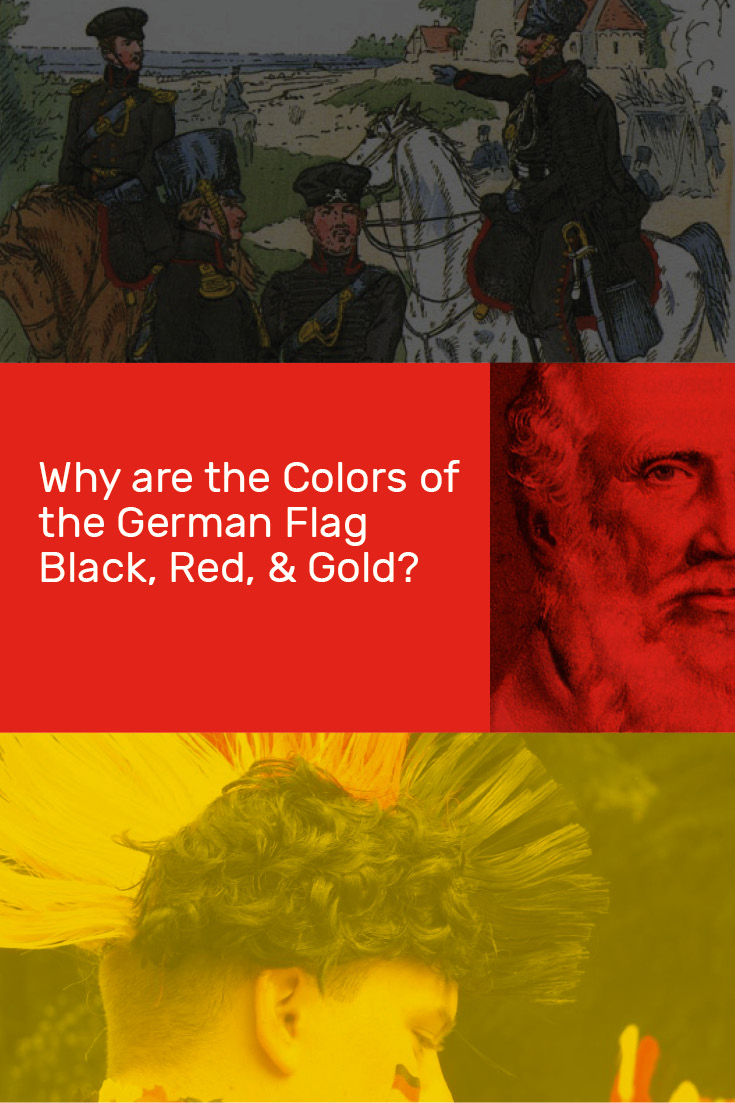Disclosure: Please note that some links are affiliate links, and at no additional cost to you, we earn a commission if you make a purchase.
If you would like to support this website in some way, using these links will help do exactly that.

It is not clearly documented how the three colors black, red and gold became a part of the German flag. However, we will take you back through the early undocumented history until today.
German Flag Color Symbolism Theories
• There are different interpretations regarding the meaning of the German flag colors, black, red, and gold.
• One interpretation argues it was inspired by a song with a text of, "Powder is black, blood is red, golden flickers the flame.”
• Another interpretation suggests "black and gold" was the color of the old empire, and red symbolized the blood spilled in the fights for freedom.
• Similarly, another interpretation goes on to say the order of the colors symbolizes German history, "Through night (black) and blood (red) to the golden light of freedom.”
• Others see the red color as a symbol of the Hohenstaufen dynasty, which, in the early German history, crowned emperors and kings.
According to the rules of heraldry (the design of coat of arms), the German flag would not exist in its familiar form. In order to ensure the identifiability of a coat of arms at greater distances, heraldry distinguished colors and metals, with yellow representing gold. This means that colors in a coat of arms cannot touch as they have to be separated by metal. In this respect, the German flag color order would have to be black-gold-red.
German Flag Speculated Beginnings
The earliest legend of the flag dates back to the time of the Napoleonic Wars, specifically 1813-1814, and a group of volunteer resistance fighters, known as Lützow Free Corps, who took any civilian clothing they could find and dyed them uniformly black. With gold buttons, red cuffs, and black uniforms, on volunteer fighters from all over Germany and Austria, it is thought this is where the inspiration of the flag colors came from.
Another theory is that Friedrich Ludwig Jahn, a German gymnastics educator, designed a black, red, and gold flag in 1812. Jahn, an outspoken nationalist, had also participated in the liberation war against Napoleon, and the black, red and gold colored flag he designed was allegedly carried in battle.
Documented History of the German Flag
Napoleon still ruled during the early 19th century, but the German Campaign battle in 1813 liberated the German states from the domination of the French and led to a reorganization of Germany in 1814. The German Confederation was founded with 37 individual states and four free cities under the presidency with Austria. This new form of government, where the new nation was controlled by a different country, had many critics longing for a unified, self-governed Germany.
Among these critics was the fraternity of the German city Jena, which had their fraternity flag colored black, red and gold. This flag became a symbol of protest against the paternalism of Austria. Among other things, the German citizens demanded the freedom of the press and freedom of opinion. To restore order, the Austrian government finally gave in and an all-German parliament was established in Frankfurt at the so-called Frankfurt Parliament in the Paulskirche. Black, red and gold was declared the official flag of Germany.
During the Nazi regime, which started in 1933, the National Socialists first supplemented the German flag with their swastika and later used a flag with the swastika on a red background.
After the end of the Nazi dictatorship and WWII, it was obvious to return to the flag which had become a symbol of freedom for Germany, even though Germany was divided into East and West. To distinguish itself from West Germany, the East German government added a coat of arms to their flag in 1959. The coat of arms showed a hammer for the working class, the circle for the thinkers, and a garland of corn for the peasants. With the end of the GDR in 1989 this variation disappeared. Since then, the simple "black-red-gold" scheme applies to the entire country.
The German Flag Today
Even today, the German flag or it's national colors are infrequently seen in Germany compared to many other European countries. Remembering the use of a flag as a propaganda tool during the Nazi regime is still present in the heads of the German people. In recent years, however, there has been a cautious resurfacing national pride, which makes it normal for Germans to claim their country and to show the national colors, especially at international sporting events, like the 2006 World Cup, which was hosted by Germany, or after winning the 2012 World Cup.
Follow Along
If you enjoyed this article, or these topics sound interesting to you, you'll love our weekly newsletter. You'll receive a free Germany Packing list for signing up, and you'll receive each week's newest posts every Friday. Thank you for reading!

Photo Credits: 1890 illustration of Prussian Lützow's Free Corps by Richard Knötel (1857-1914). | 1852 lithograph of Friedrich Ludwig Jan | 2006 World Cup in Berlin, photo by Alexander Husing, flickr user azrael74 with Attribution 2.0 Generic .
